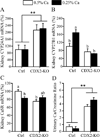Compensatory Changes in Calcium Metabolism Accompany the Loss of Vitamin D Receptor (VDR) From the Distal Intestine and Kidney of Mice
- PMID: 26211511
- PMCID: PMC4846362
- DOI: 10.1002/jbmr.2600
Compensatory Changes in Calcium Metabolism Accompany the Loss of Vitamin D Receptor (VDR) From the Distal Intestine and Kidney of Mice
Abstract
1,25 Dihydroxyvitamin D3 (1,25(OH)2 D) increases intestinal Ca absorption when dietary Ca intake is low by inducing gene expression through the vitamin D receptor (VDR). 1,25(OH)2 D-regulated Ca absorption has been studied extensively in the small intestine, but VDR is also present in the large intestine. Our goal was to determine the impact of large intestinal VDR deletion on Ca and bone metabolism. We used transgenic mice expressing Cre-recombinase driven by the 9.5-kb human caudal type homeobox 2 (CDX2) promoter to delete floxed VDR alleles from the caudal region of the mouse (CDX2-KO). Weanling CDX2-KO mice and control littermates were fed low (0.25%) or normal (0.5%) Ca diets for 7 weeks. Serum and urinary Ca, vitamin D metabolites, bone parameters, and gene expression were analyzed. Loss of the VDR in CDX2-KO was confirmed in colon and kidney. Unexpectedly, CDX2-KO had lower serum PTH (-65% of controls, p < 0.001) but normal serum 1,25(OH)2 D and Ca levels. Despite elevated urinary Ca loss (eightfold higher in CDX2-KO) and reduced colonic target genes TRPV6 (-90%) and CaBPD9k (-80%) mRNA levels, CDX2-KO mice had only modestly lower femoral bone density. Interestingly, duodenal TRPV6 and CaBPD9k mRNA expression was fourfold and threefold higher, respectively, and there was a trend toward increased duodenal Ca absorption (+19%, p = 0.076) in the CDX2-KO mice. The major finding of this study is that large intestine VDR significantly contributes to whole-body Ca metabolism but that duodenal compensation may prevent the consequences of VDR deletion from large intestine and kidney in growing mice.
Keywords: CA METABOLISM; CDX2P9.5; LARGE INTESTINE; VITAMIN D; VITAMIN D RECEPTOR.
© 2015 American Society for Bone and Mineral Research.
Conflict of interest statement
Figures





Similar articles
-
Transgenic Expression of the Vitamin D Receptor Restricted to the Ileum, Cecum, and Colon of Vitamin D Receptor Knockout Mice Rescues Vitamin D Receptor-Dependent Rickets.Endocrinology. 2017 Nov 1;158(11):3792-3804. doi: 10.1210/en.2017-00258. Endocrinology. 2017. PMID: 28938396 Free PMC article.
-
Intestinal responses to 1,25 dihydroxyvitamin D are not improved by higher intestinal VDR levels resulting from intestine-specific transgenic expression of VDR in mice.J Steroid Biochem Mol Biol. 2020 Jun;200:105670. doi: 10.1016/j.jsbmb.2020.105670. Epub 2020 Apr 10. J Steroid Biochem Mol Biol. 2020. PMID: 32283207
-
Intestinal vitamin D receptor is required for normal calcium and bone metabolism in mice.Gastroenterology. 2009 Apr;136(4):1317-27, e1-2. doi: 10.1053/j.gastro.2008.12.051. Epub 2008 Dec 27. Gastroenterology. 2009. PMID: 19254681 Free PMC article.
-
Intestinal calcium absorption: Molecular vitamin D mediated mechanisms.J Cell Biochem. 2003 Feb 1;88(2):332-9. doi: 10.1002/jcb.10360. J Cell Biochem. 2003. PMID: 12520535 Review.
-
Vitamin D and type II sodium-dependent phosphate cotransporters.Contrib Nephrol. 2013;180:86-97. doi: 10.1159/000346786. Epub 2013 May 6. Contrib Nephrol. 2013. PMID: 23652552 Review.
Cited by
-
Combined Deletion of the Vitamin D Receptor and Calcium-Sensing Receptor Delays Wound Re-epithelialization.Endocrinology. 2017 Jun 1;158(6):1929-1938. doi: 10.1210/en.2017-00061. Endocrinology. 2017. PMID: 28368538 Free PMC article.
-
Vitamin D and intestinal calcium transport after bariatric surgery.J Steroid Biochem Mol Biol. 2017 Oct;173:202-210. doi: 10.1016/j.jsbmb.2016.12.012. Epub 2016 Dec 24. J Steroid Biochem Mol Biol. 2017. PMID: 28027914 Free PMC article. Review.
-
Vitamin D and Gut Health.Adv Exp Med Biol. 2022;1390:155-167. doi: 10.1007/978-3-031-11836-4_9. Adv Exp Med Biol. 2022. PMID: 36107318 Free PMC article.
-
Intestinal Vitamin D Receptor Is Dispensable for Maintaining Adult Bone Mass in Mice With Adequate Calcium Intake.Endocrinology. 2023 Mar 13;164(5):bqad051. doi: 10.1210/endocr/bqad051. Endocrinology. 2023. PMID: 36960562 Free PMC article.
-
The role of vitamin D in the endocrinology controlling calcium homeostasis.Mol Cell Endocrinol. 2017 Sep 15;453:36-45. doi: 10.1016/j.mce.2017.04.008. Epub 2017 Apr 9. Mol Cell Endocrinol. 2017. PMID: 28400273 Free PMC article. Review.
References
-
- Fleet JC. Molecular Regulation of Calcium Metabolism. In: Weaver CM, Heaney RP, editors. Calcium in Human Health. Nutrition and Health. Totowa, NJ: Humana Press; 2006. pp. 163–190.
-
- Song Y, Peng X, Porta A, et al. Calcium transporter 1 and epithelial calcium channel messenger ribonucleic acid are differentially regulated by 1,25 dihydroxyvitamin D3 in the intestine and kidney of mice. Endocrinology. 2003;144(9):3885–3894. - PubMed
-
- Pansu D, Bellaton C, Roche C, Bronner F. Duodenal and ileal calcium absorption in the rat and effects of vitamin D. Am J Physiol. 1983;244(6):G695–G700. - PubMed
Publication types
MeSH terms
Substances
Grants and funding
LinkOut - more resources
Full Text Sources
Other Literature Sources
Molecular Biology Databases
Research Materials

